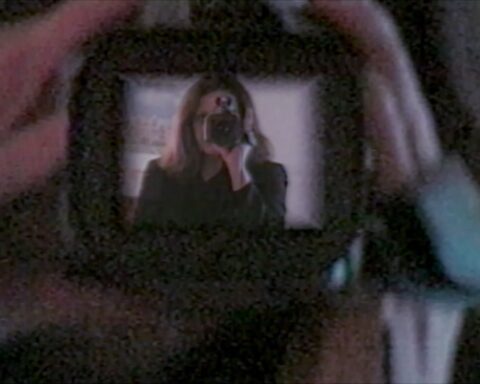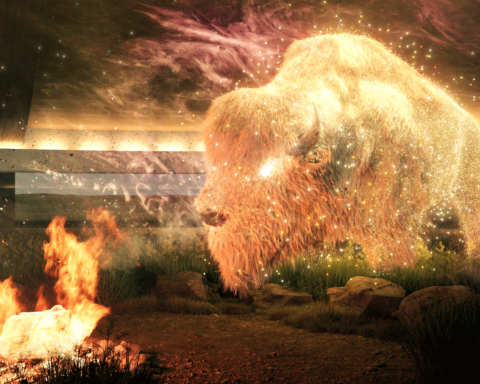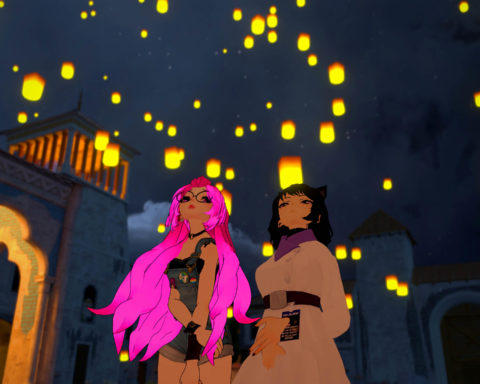One July evening in a backyard in Toronto, I happened to illustrate my deep obsession with Peter Greenaway to Gabe Sawhney. Along with Shawn Micallef, Gabe is responsible for the celebrated new media art project , which allows cell-phone flaneurs to listen to true stories about the urban places they walk through. Gabe informed me that Greenaway had become a VJ, and would be doing his North American premiere at a massive festival of electronic art in California. He and Shawn were going as representatives of the Canadian Film Center’s Habitat New Media Lab, which would be hosting Greenaway’s event.
“Can I come?” I asked, stunned.
“Yeah, yeah,” said Gabe. “You can sleep on our floor.”
One month later I became perhaps the first new media groupie as I followed [murmur] to San Jose for the combined event of the inaugural ZeroOne festival of electronic art and the 13th Symposium of the Inter-Society for Electronic Art (ISEA). Greenaway cancelled his appearance two days before my flight south, but I went anyway, planning to witness the festival like an innocent bystander. I played a role-playing game as a deer with a human face galloping through a forest, let a vat of archaebacteria predict my future in words taken from the Apocrypha, and gazed wonderingly through a microscope at a one millionth-scale version of Frank Lloyd Wright’s building Fallingwater. I spent the whole week feeling deeply startled. San Jose seemed tipped on the crest of a wave about to break off in a new direction and douse everyone with something strange and new.
On my first day, I started with Taiwanese artist Shu Lea Chiang’s project BABY LOVE. Candy- coloured teacups fitted with steering wheels and enourmous babies made of pink rubber floated in a sludge-paced swirl through the sunlit atrium of San Jose’s geodesic city hall. A wireless device fixed to the wall allowed you to upload songs from your ipod to the babies, who then “sang” them. If you bumped another teacup, the babies traded songs. Thinking about the spectacle of white babies in teacups, I asked Cheang if the piece commented on colonialism or racism. She looked shocked, and said, “No! It’s about cloning!”
I’m so inured to consumer culture that corporate sponsorship had seemed a normal accessory to the extravagantly fanciful BABY LOVE. While Acclair highlighted the ability of technology to destroy privacy and the boundaries between commerce and governance, it also put our acceptance of corporate sponsorship into sharp relief. The more appropriative the company, the more plausible it seems. Luther Thie and Eyal Fried, the award-winning artists who created Acclair, used this assumption like painters use colour. Artists usually revel in skewering the assumptions of viewers, but artworks in traditional media don’t tend to incorporate those assumptions into their very structure. Gothic cathedrals can be seen by everyone, not only medieval Christians, but Acclair’s chimera depended on my hallucination of “normal.”
After seeing Acclair, I no longer felt like an innocent bystander at the festival. Instead of being a willing but passive responder to the artworks, in some unsettling way I often felt responsible for them because of the interaction they required. Still, thinking back to my initial cinematic interest at the festival, I felt only slightly nostalgic for the non- interactive experience of watching a movie. Cinema seemed backwards compared to these works of aesthetic interaction. Although theatre allows audiences to communicate with performers through applause and laughter, as we watch a film we have no avenues by which to change it: its sounds and images replace our own reality. Performative cinema, therefore, would allow audience- members to communicate with the filmmaker, if only through applause, and so influence the spectacle, engaging the interactive aesthetic of new media.
Before its last-minute cancellation, Greenaway’s event had been part of a performative cinema series curated by Ana Seranno, the director of the Canadian Film Centre’s Habitat New Media Lab. To replace him, Mike Figgis did a live mix of Timecode (2000) in a giant room filled with infinitely adjustable “ultra high-tech” chairs that encouraged audience members to swivel and roll about the floor. The film breaks both visual and narrative conventions by showing four simultaneous perspectives on the same group of characters in a screen split four ways. In his live mix, Figgis highlighted or subdued the sound from each of the screens so as to retell the story in a different way, saying afterwards that he believed a live mix could change the way audience members thought of the story. When asked about the possibility of audience interaction, however, Figgis replied that the piece was not conceived to be “audience friendly,” and that allowing the audience to mix the sound themselves probably wouldn’t have worked. Despite its experimentation, Figgis’ performance ultimately didn’t break any barriers between audience and filmmaker.
VJ Michael Lew created a more interactive style of cinema with Junkyard of Dreams, an improvised performance of video clips accompanied by a jazz-fusion band. Lew juxtaposed shots of “real” people and streets in LA with iconic clips from Hollywood movies (such as Julia Roberts’ thong and tummy in the opening moments of Pretty Woman, and Joe Gillis’s body floating in the pool at the beginning of Sunset Boulevard). As the clips changed in rhythm and tone, so did the music. Afterwards the musicians claimed the performance had been a completely even collaboration between themselves and the VJ. From the perspective of the audience, however, the driving influence seemed more one-sided in favor of Lew and his clips. His images of buildings collapsing in reverse, or the static shot of a missile intercut with shots of a parade of Arabs on camels moving forwards and backwards, gave the piece political meaning that the music could only accompany, not develop. While the piece did depend on the interaction between the filmmaker and the musicians, ultimately Lew still had auteur- like control.
Morten Schjødt’s Switching (2003), the final screening in the performative cinema series, incorporated the aesthetic of live cinema completely differently. Made to be controlled by an individual watching on a home set, a click of the remote ant any moment puts the film on a new course. Schjødt took full advantage of DVD technology to create a sprawling narrative of looped scenes and variations improvised by the actors, which all intersect at different points like a “choose your own adventure” novel without clues or pages. The film screened twice in one evening—once as a “director’s cut,” during which Schjødt controlled the remote and “switched” scenes according to his own map of the DVD, and once as an “audience cut,” at which point he had viewers pass the remote around and choose themselves when to stop a scene and look for something else. The story was completely different each time; the audience not only interacted with the film, but tangibly affected its progression.
Only one other project at the festival, Obsession by Pia Tikka, Rasmus Vuori, and Joonas Juutilainen, created a cinematic display that changed according to audience input. A single audience member sits in a “smart chair” that collects data in roughly fifteen physiological categories, including pulse, temperature, breath rate, and general “fidgetyness.” A complex algorithm computes this information to create a sequence from a collection of shots rated for “emotional content” according to colour, pattern, movement, gesture, and narrative meaning. The computer narrative may lack coherence, but it does answer the desires the audience member unwittingly communicates. The ambition of these filmmakers to make an “unconsciously interactive” piece suggests an anxiety about the repression of audiences in traditional media, as well as nostalgia for the relaxation of “just watching” a movie. Like Acclair, this project purposefully melts boundaries between reality and spectacle.
While each of these interactive cinema projects retain the basic formal characteristics of film and video (they all consist of sound and filmed shots), the most moving cinematic spectacle I witnessed at the festival had done away with the camera. I stumbled upon Mark Hansen and Ben Rubin’s Listening Post in a darkened room of San Jose’s Museum of Art. Conceived in response to the question “What would 100, 000 people chatting on the Internet look like?” the work consists of twenty-one vertical strings of eleven glowing LCDs, strung up in a rectangle the scale of a movie screen. Projecting scraps of dialogues lifted in real time from Internet chat rooms, the screens ticked as their displays change, and seemed to sway gently on their wires with the impact of each new message. Viewers could sit on low plush blocks at the back of the room, or stand and walk about the space, while a man (who sounded not unlike Peter Greenaway) listed sentences beginning with the words “I like” over a dreamy soundtrack.
I suspected Listening Post might be the culmination of all the interactive cinema pieces I’d seen: it made a spectacle of real interaction, gave its audience a refreshing liberty and let itself be altered spontaneously by its topic, the chat rooms. By this point in the festival I had been completely persuaded by the demand of new media to combine and reassess older art forms, and modes of interpretation. [murmur] too, I realized, could be considered as an inheritor of cinematic storytelling, a cinéma vérité of place and setting, a spectacle that, by being real, creates the most intense virtual reality. If the cinema’s walls crumbled, we’d be left sitting on a street corner, gazing at the strangers around us and wondering if they had any good stories to tell.
Exhausted by watching all the lines between spectacle and reality evaporate, halfway through the week Shawn and I escaped the frenzy of San Jose and drove forty miles south to Santa Cruz to stare at the antique rides and slot machines along its seaside boardwalk. As promised, a creaking rollercoaster jolted passengers over a man-made landscape above air dank with bodies. Reclined on my new beach towel beside the small and muddy waves, I tried to shut out the sounds of Santa Cruz, but couldn’t erase the screams coming from across two hundred meters of beach behind us. A piston fifty- feet tall was thrusting a bundle of humans up and down the height of its shaft as fast as a steam engine. I wondered how much time elapsed after the invention of steam power before someone used it for this kind of amusement. At that moment, a steam piston one thousand times its usual size seemed very similar to a one- millionth-sized version of Frank Lloyd Wright’s Fallingwater: both tease us into questioning how we fit ourselves as human-sized beings into a technologically complex landscape. I looked up a hundred feet in the air to see small children dangling their feet and pointing from floating buggies coloured like BABY LOVE teacups. I watched these spectacles like a voyeur, but, as another body in the crowd, I felt vaguely responsible for the strange din on the beach. The line between the avant-garde art world we’d left and the time capsule we’d found began to blur in a disturbing way.











